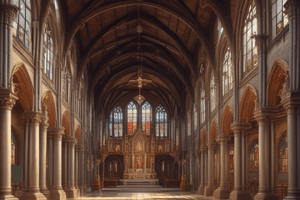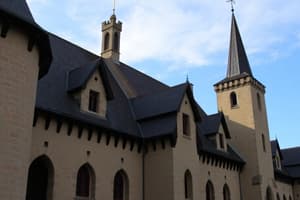Podcast
Questions and Answers
What significant socio-economic change occurred in Western Europe between the 9th and 16th centuries?
What significant socio-economic change occurred in Western Europe between the 9th and 16th centuries?
The primary change was in land ownership and the spread of Christianity.
Why have historians studied individual villages in medieval Europe?
Why have historians studied individual villages in medieval Europe?
Historians have found abundant historical documents that provide insights into local life.
Who was Marc Bloch, and what was his contribution to the study of European history?
Who was Marc Bloch, and what was his contribution to the study of European history?
Marc Bloch was a historian who emphasized the importance of collective behavior and societal attitudes in history.
What role did church records play in understanding medieval European society?
What role did church records play in understanding medieval European society?
What was the focus of the chapter regarding the Three Orders in medieval society?
What was the focus of the chapter regarding the Three Orders in medieval society?
What was one of the sources of insight into community activities during the medieval period?
What was one of the sources of insight into community activities during the medieval period?
What does the term 'feudalism' refer to in the context of medieval Europe?
What does the term 'feudalism' refer to in the context of medieval Europe?
What is noted as a developmental transition in the chapter from the Three Orders?
What is noted as a developmental transition in the chapter from the Three Orders?
What does the term 'feud' refer to in the context of feudalism?
What does the term 'feud' refer to in the context of feudalism?
Who is Marc Bloch?
Who is Marc Bloch?
How did Marc Bloch's career end?
How did Marc Bloch's career end?
Who defeated the Saxon king of England?
Who defeated the Saxon king of England?
What are the three orders of society according to French priests?
What are the three orders of society according to French priests?
What role did the Catholic Church play in feudal society?
What role did the Catholic Church play in feudal society?
In which century did feudalism develop in England?
In which century did feudalism develop in England?
What significant title was conferred to King Charlemagne by the Pope?
What significant title was conferred to King Charlemagne by the Pope?
What was the relationship between lords and peasants in feudalism?
What was the relationship between lords and peasants in feudalism?
Where did the name 'France' originate?
Where did the name 'France' originate?
What ceremony from feudal customs did the Church adopt?
What ceremony from feudal customs did the Church adopt?
How did old traditions influence Christmas and Easter?
How did old traditions influence Christmas and Easter?
What was the primary life focus of monks in monasteries?
What was the primary life focus of monks in monasteries?
What role did pilgrimage play in Christian life?
What role did pilgrimage play in Christian life?
What distinguished friars from traditional monks?
What distinguished friars from traditional monks?
What criticism about monastic life is reflected in Langland's poem?
What criticism about monastic life is reflected in Langland's poem?
What significant change did St. Benedict's and Cluny's monasteries introduce?
What significant change did St. Benedict's and Cluny's monasteries introduce?
What was the nobility's role within the feudal system?
What was the nobility's role within the feudal system?
How were women involved in monastic life?
How were women involved in monastic life?
What privileges did nobles enjoy in the feudal system?
What privileges did nobles enjoy in the feudal system?
Flashcards are hidden until you start studying
Study Notes
Introduction
- Western Europe experienced significant socio-economic and political transformations from the 9th to the 16th centuries.
- Christianity expanded influence across Central and Northern Europe following the decline of Roman authority.
Sources of Medieval European Society
- Historians have examined extensive historical documents, including land ownership records and church records, to study medieval European society.
- These records include legal cases, birth, marriage, and death registrations, aiding in understanding family structures and population dynamics.
- Cultural insights come from inscriptions in churches and folklore, highlighting festivals and community life.
Concept of European Feudalism
- Marc Bloch was influential in defining the concept of feudalism, emphasizing the significance of social, economic, and geographical factors beyond political events.
- He highlighted collective behaviors and attitudes shaping societal structures during medieval times.
Feudalism
- Feudalism describes the intertwined economic, legal, and political relationships prevalent from the 5th to the 15th centuries.
- This system was characterized by lords providing military protection to peasants in exchange for labor, establishing a social hierarchy.
Feudalism in France and England
- Gaul, eventually becoming France, was rich in natural resources, facilitating agriculture.
- The French kings established close ties with the Catholic Church, influencing social structures and political legitimacy.
- In the 11th century, William the Conqueror brought feudalism to England after defeating the Saxons, redistributing land to Norman nobles who owed military service to the king.
The Three Orders
- Society was classified into three orders: the Clergy, the Nobility, and the Peasantry, based on occupation.
The First Order: The Clergy
- The Catholic Church held significant power, independent of royal authority, controlling lands and taxes.
- The Pope served as the head of the Western Church, residing in Rome, which solidified church authority.
The Church and Feudalism
- Ceremonies and symbols from feudal culture, such as acts of loyalty and the term "lord" for God, were adapted into church practices.
The Church and Society
- Christianity integrated into European life while old pagan traditions persisted.
- Major Christian festivals like Christmas and Easter replaced pre-existing celebrations, with local customs adapting to religious observance.
- Pilgrimages to holy sites became essential for Christians, blending spiritual devotion with community engagement.
Monks
- Monks formed isolated religious communities, distinct from secular clergy, living in monasteries established by figures like St. Benedict and at Cluny.
Life of Monks
- Monastic life required lifelong vows of stability, prayer, study, and labor, including agriculture, encompassing both men and women (nuns).
- Monasteries consisted of self-sufficient communities dedicated to spiritual and communal activities.
Monasteries
- Monasteries grew into significant establishments with extensive estates and educational institutions.
- The 14th century raised questions about monastic values, critiques evident in literature, such as Langland's "Piers Plowman" and Chaucer's "Canterbury Tales."
The Second Order: The Nobility
- Nobility, recognized as the second order by the clergy, wielded considerable power through land ownership resulting from vassalage.
- The relationships between kings and nobility were crucial due to the obligations of landholding and military service.
Studying That Suits You
Use AI to generate personalized quizzes and flashcards to suit your learning preferences.




